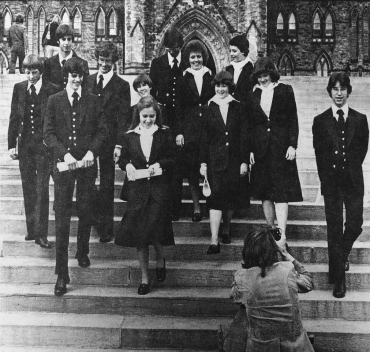History
Pages first began working in the House during the early years of Confederation. At that time, young boys, often from families experiencing financial difficulty, were chosen to become pages. Historical records also indicate the importance of their small stature. Once the boys grew tall, they often also outgrew their roles as pages.
Since then, many changes have been made to the position of a page and the program has evolved, ensuring an inclusive environment and an emphasis on the continuation of education for those employed. The program as we know it today was introduced in 1978 by the Honourable James A. Jerome, who was then the Speaker of the House. A few years earlier, in 1974, the Speaker had asked the Clerk of the House to prepare a report as part of a review of the existing program.
A report prepared in the mid-1970s by the Standing Committee on Management and Members’ Services concluded that the Canadian page program was unsatisfactory for a number of reasons and that, in order to meet the demands of a modern society, it should achieve the following objectives:
- symbolize the national character of Parliament;
- increase the public’s knowledge of parliamentary proceedings;
- provide high-quality service to members; and
- offer employment opportunities for young people, with no discrimination on the basis of sex.
As of 1978, the position of a page was offered to graduating high school and CEGEP students from across Canada beginning their studies at one of the universities in the national capital region. In doing so, the program could meet the objectives set out in the report. Today, pages come from diverse backgrounds and attend various universities and colleges in Ottawa-Gatineau.
At the time of the program’s renewal, Speaker Jerome addressed members in the House, stating the following: “We know we will benefit greatly from [the pages’] presence here and we hope they will as well and, indeed, that in future years the entire country will benefit from having these citizens back in the country, better equipped through education and through their exposure here to a practical knowledge of the Canadian House of Commons” (Debates, October 10, 1978, p. 6953).
If you would like to learn more about the history of the page program, you may be interested in the following articles:
- Bosc, Marc. “The Commons Then and Now: Pages.” Canadian Parliamentary Review,12(2), Summer 1989.
- Levy, Gary. “Pages in Parliament and the Legislatures." Canadian Parliamentary Review. 2(2), June 1979.

1978 Page Program cohort, the first to include girls. They are seen here walking down the stairs in front of Centre Block. Published in The Ottawa Citizen, named The Citizen at the time, on Friday, September 29, 1978. Photo by Bill Brennan, Citizen photographer.

Pages in good company. Front row, left to right: Leon J. Raymond, Clerk of the House of Commons; Louis St. Laurent, Prime Minister; and Lieutenant-Colonel W.J. Frankline, Sergeant-at-Arms. Photo by G. Lunney. Courtesy of Library and Archives Canada.